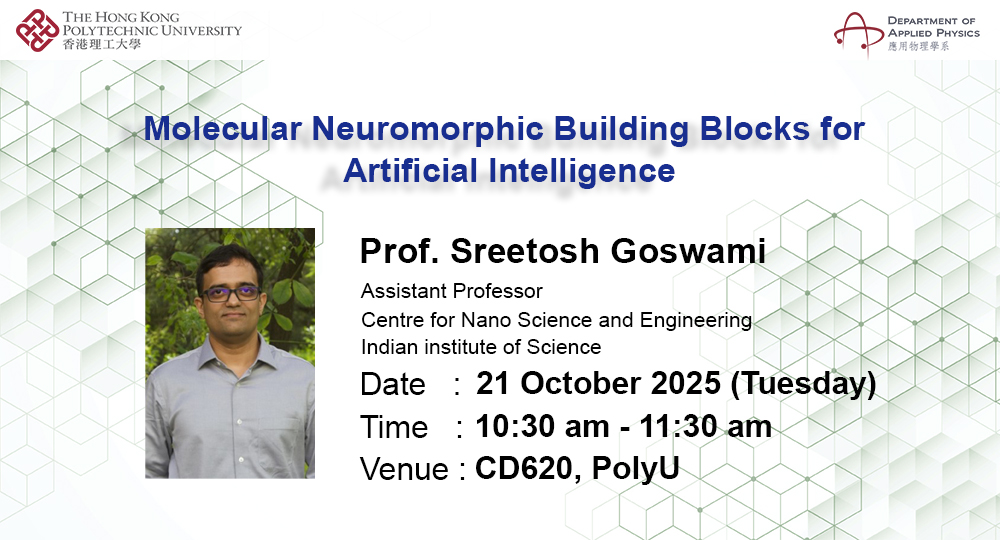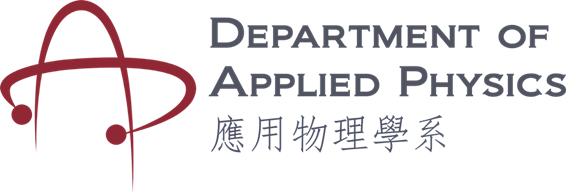AP Seminar - Molecular Neuromorphic Building Blocks for Artificial Intelligence

-
Date
21 Oct 2025
-
Organiser
-
Time
10:30 - 23:30
-
Venue
CD620, 6/F, Wing CD, PolyU Map
Speaker
Prof. Sreetosh Goswami
Summary
Artificial Intelligence (AI) has long been a subject of fascination, oscillating between grand promises and inevitable disillusionment. While remarkable milestones, like AI outperforming human champions in complex games, suggest we are entering a new era of computing, a deeper look reveals that these breakthroughs come at a steep cost — demanding vast amounts of energy and intensive, expensive training process. In areas like cognition, decision-making, and intelligence, even our most advanced computing machines fall far short of the brain’s unparalleled efficiency and compact design. The core of this challenge lies in the limitations of conventional circuit elements and computing architectures, which struggle to replicate the brain’s complex, nonlinear dynamics operating at the edge of chaos. In this seminar, I will introduce a new class of molecular circuit elements designed to capture the intricate, reconfigurable logic that mimics brain-like behaviour at the nanoscale. These devices can be operated as analog or digital elements, or could be poised on the verge of instability, offering a unique potential to emulate neural functions in ways that traditional computing hardware cannot. Our journey explores these molecular systems from their foundational physics and chemistry, all the way to integrated circuit design and on-chip applications [1-8] with the aim of laying the groundwork for AI and machine learning platforms that can transcend the limitations of Moore's Law and lead to a new era of energy-efficient computing. [1] S, H., Bhat, N. & Goswami, S. Neuromorphic pathways for transforming AI hardware. Nat Electron 8, 752–756 (2025). https://doi.org/10.1038/s41928-025-01432-z [2] Sharma, D., Rath, S.P., Kundu, B., Korkmaz, A., Thompson, D., Bhat, N., Goswami, S., Williams, R.S. and Goswami, S. Linear symmetric self-selecting 14-bit kinetic molecular memristors. Nature 633, 560–566 (2024). [3] Sreebrata Goswami, Williams, R. Stanley, and Sreetosh Goswami. "Potential and challenges of computing with molecular materials." Nature Materials (2024): 1-11. [4] Rath, S. P., Deepak, Goswami, S., Williams, R. S., & Goswami, S. Energy and Space Efficient Parallel Adder Using Molecular Memristors. Advanced Materials (2023), 2206128. [5] Rath, Santi Prasad, Thompson, Damien, Goswami, Sreebrata, & Goswami, Sreetosh. "Many‐body molecular interactions in a memristor." Advanced Materials (2023): 2204551. [6] Goswami, Sreetosh, et al. "Decision trees within a molecular memristor." Nature 597.7874 (2021): 51-56. [7] Goswami, Sreetosh, et al. "Robust resistive memory devices using solution-processable metal-coordinated azo aromatics." Nature Materials 16.12 (2017): 1216-1224.
Keynote Speaker
Prof. Sreetosh Goswami
Assistant Professor
Centre for Nano Science and Engineering
Indian Institute of Science
Sreetosh Goswami is an Assistant Professor and Pratiksha Trust Young Investigator Chair at the Centre for Nanoscience and Engineering (CeNSE), Indian Institute of Science. He obtained his Ph.D. from the National University of Singapore. His graduate research was recognized with the Graduate Student Awards (Gold Medal) from both the Materials Research Society (MRS) and the European Materials Research Society (EMRS). He has since been named a Young Associate of the Indian Academy of Sciences (2024), elected as an Indian National Science Academy Young Investigator (2025), and received the Wiley Young Innovator Award (2025). Sreetosh’s research focuses on developing energy-efficient neuromorphic hardware for AI, with applications in deep learning, signal and image processing, and bioinformatics. His group is motivated by the broader goal of advancing computing paradigms beyond traditional limits, while contributing tools and insights that serve the scientific community at large.




